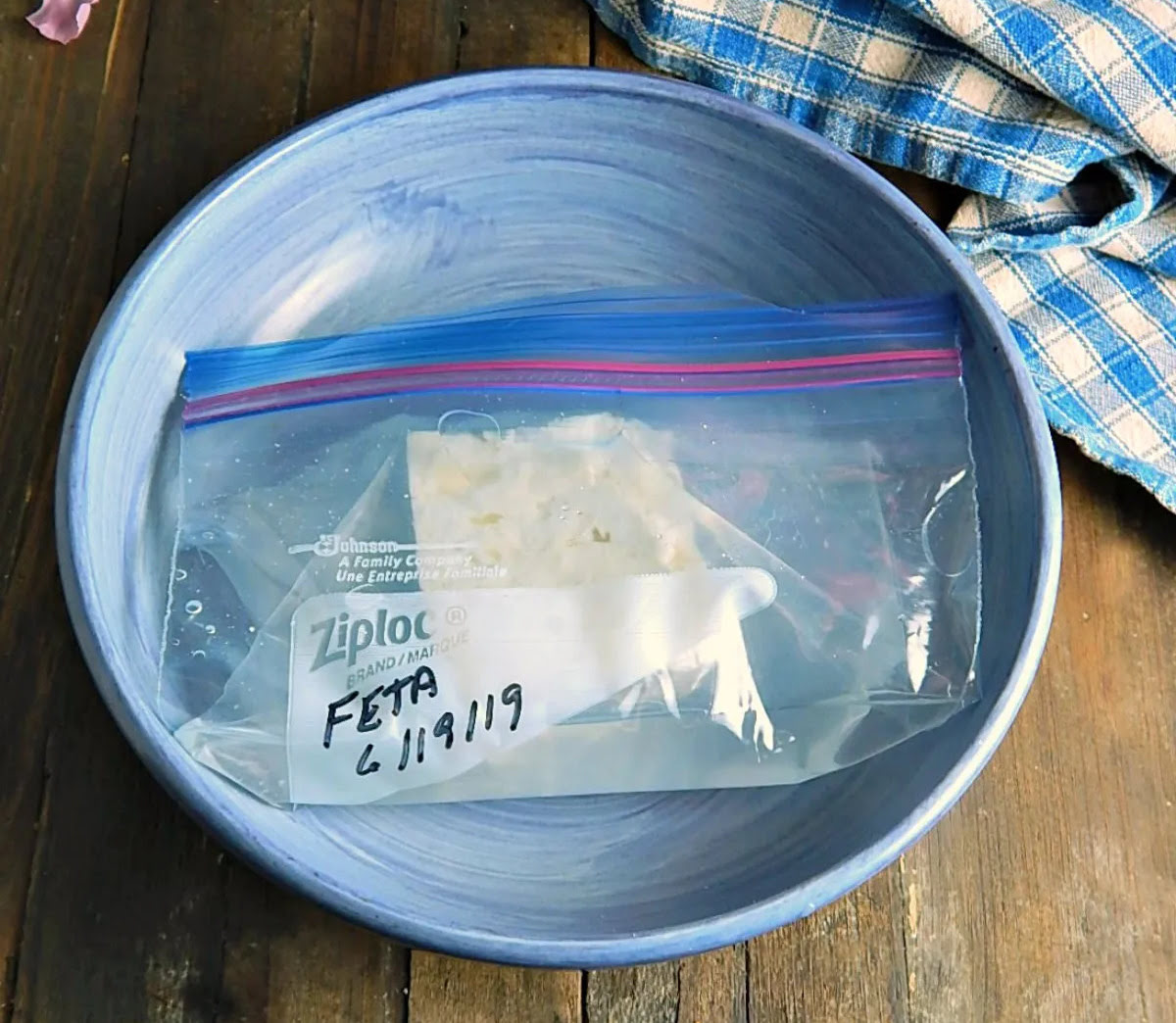

Articles
How To Store Feta
Modified: January 8, 2024
Discover the best methods for storing feta cheese in this informative collection of articles. Keep your feta fresh and flavorsome with these expert tips.
(Many of the links in this article redirect to a specific reviewed product. Your purchase of these products through affiliate links helps to generate commission for Storables.com, at no extra cost. Learn more)
Introduction
When it comes to storing feta cheese, proper handling and storage techniques are of utmost importance. Feta is a delicious and versatile cheese originating from Greece, known for its crumbly texture and tangy taste. Whether you use feta as a topping for salads, a filling for pastries, or a flavor enhancer for various dishes, ensuring its freshness and quality is essential.
Proper feta storage methods help to maintain the cheese’s taste, texture, and overall quality. This involves taking the necessary steps to prevent spoilage and preserve its unique flavors. In this article, we will explore the significance of proper feta storage and guide you through the best practices for storing feta cheese to ensure its longevity.
Key Takeaways:
- Proper feta storage is essential to maintain its freshness, flavor, texture, and nutritional value. Follow best practices such as refrigeration, airtight containers, and brine to preserve the unique qualities of this versatile cheese.
- When storing feta, choose high-quality options, consider factors like milk type, age, texture, and saltiness, and explore various storage methods such as brine, olive oil, vacuum-sealed bags, saltwater solutions, and freezing to extend its shelf life.
Read more: How To Store Feta Cheese
Why Proper Feta Storage is Important
Proper storage of feta cheese is crucial for several reasons. Firstly, feta is a perishable dairy product that can spoil if not stored correctly. Exposure to air, moisture, and varying temperatures can accelerate the spoiling process, resulting in a loss of flavor, texture, and nutritional value.
Secondly, feta cheese is susceptible to bacterial growth, particularly if kept in unsanitary conditions or at incorrect temperatures. Improper storage can lead to the growth of harmful bacteria, such as Listeria monocytogenes, which can cause foodborne illnesses.
Lastly, storing feta properly helps to maintain its unique characteristics. Feta cheese has a distinct flavor profile and texture that should be preserved to ensure an enjoyable culinary experience. By employing proper storage techniques, you can savor the authentic flavors of feta and its versatility in various recipes.
Choosing the Right Feta for Storage
When it comes to selecting feta cheese for storage, it is crucial to choose high-quality feta from reputable sources. Look for feta made from 100% sheep’s milk or a combination of sheep’s and goat’s milk, as this will ensure the authentic taste and texture of traditional Greek feta.
Inspect the packaging for a seal of authenticity or a PDO (Protected Designation of Origin) certification. These indicators guarantee that the feta cheese is sourced from specific regions in Greece, where traditional feta-making methods are followed. This ensures the highest quality and the true essence of feta cheese.
Additionally, consider the age of the feta cheese. Younger feta, typically aged for a few weeks, has a milder flavor, while older feta, aged for several months, develops a more pronounced tanginess. Choose the age of feta that suits your taste preferences and intended usage.
Key Takeaways:
- Proper feta storage is essential to maintain its freshness, flavor, texture, and nutritional value. Follow best practices such as refrigeration, airtight containers, and brine to preserve the unique qualities of this versatile cheese.
- When storing feta, choose high-quality options, consider factors like milk type, age, texture, and saltiness, and explore various storage methods such as brine, olive oil, vacuum-sealed bags, saltwater solutions, and freezing to extend its shelf life.
Read more: How To Store Feta Cheese
Why Proper Feta Storage is Important
Proper storage of feta cheese is crucial for several reasons. Firstly, feta is a perishable dairy product that can spoil if not stored correctly. Exposure to air, moisture, and varying temperatures can accelerate the spoiling process, resulting in a loss of flavor, texture, and nutritional value.
Secondly, feta cheese is susceptible to bacterial growth, particularly if kept in unsanitary conditions or at incorrect temperatures. Improper storage can lead to the growth of harmful bacteria, such as Listeria monocytogenes, which can cause foodborne illnesses.
Thirdly, improper storage can alter the texture of feta cheese. When feta is exposed to air, it can become dry and crumbly, losing its creamy and slightly moist consistency. This texture change can affect the overall enjoyment of feta in various dishes.
Furthermore, feta cheese has a distinct flavor profile that can be greatly affected by storage conditions. If exposed to excessive moisture or certain odors, feta can absorb unwanted flavors, leading to a less desirable taste. By storing feta properly, you can ensure that it maintains its authentic, tangy flavor.
Lastly, proper feta storage preserves the cheese’s nutritional value. Feta contains essential nutrients like protein and calcium, which can be compromised if the cheese is stored improperly. By keeping feta in optimal conditions, you can retain its nutritional benefits and make the most out of this versatile cheese.
To summarize, proper feta storage is important to maintain the cheese’s freshness, flavor, texture, and nutritional value. By following proper storage techniques, you can prevent spoilage, inhibit bacterial growth, preserve the creamy texture and tangy taste, and retain the cheese’s nutritional benefits. Now that we understand the significance of proper feta storage, let’s explore the best practices to ensure the longevity and quality of your feta cheese.
Choosing the Right Feta for Storage
When it comes to selecting feta cheese for storage, it is crucial to choose high-quality feta from reputable sources. Look for feta made from 100% sheep’s milk or a combination of sheep’s and goat’s milk, as this will ensure the authentic taste and texture of traditional Greek feta.
Inspect the packaging for a seal of authenticity or a PDO (Protected Designation of Origin) certification. These indicators guarantee that the feta cheese is sourced from specific regions in Greece, where traditional feta-making methods are followed. This ensures the highest quality and the true essence of feta cheese.
Consider the age of the feta cheese. Younger feta, typically aged for a few weeks, has a milder flavor, while older feta, aged for several months, develops a more pronounced tanginess. Choose the age of feta that suits your taste preferences and intended usage.
Take note of the texture of the feta cheese. Traditional feta has a crumbly and slightly moist texture, while some variations may be creamier. Decide which texture you prefer based on your personal preferences and the specific recipes you plan to use the feta in.
Additionally, consider the saltiness level of the feta cheese. Feta is typically salty due to the brining process, but the saltiness can vary among different brands or types of feta. If you prefer a less salty flavor, look for low-sodium feta options or soak the feta in water for a short time to reduce the salt content.
Lastly, pay attention to the packaging of the feta cheese. Vacuum-sealed packages or containers that protect the cheese from exposure to air and moisture are ideal for longer-term storage. Opt for feta cheese that is stored in brine or packed in a way that retains its freshness and prevents drying out.
By selecting high-quality feta cheese from trusted sources, considering factors such as milk type, age, texture, saltiness, and packaging, you can ensure that you have the best feta for storage. Now that we’ve covered the basics of choosing the right feta, let’s delve into the best practices for storing feta cheese to keep it fresh and delicious.
Read more: How To Store Feta Cheese Once Opened
Best Practices for Storing Feta
To ensure the longevity and quality of your feta cheese, follow these best practices for proper storage:
- Keep feta refrigerated: Feta cheese should always be stored in the refrigerator, as it is a perishable dairy product. The cool temperature helps to slow down the bacterial growth and preserve the freshness of the cheese.
- Store feta in an airtight container: Transfer the feta cheese into an airtight container or wrap it tightly with plastic wrap to prevent exposure to air. This step is crucial in maintaining the cheese’s moisture and preventing it from drying out.
- Consider the feta’s original packaging: If the feta cheese came in a vacuum-sealed package or a container filled with brine, it is best to keep the cheese in its original packaging. The brine helps to keep the feta moist and preserve its flavors.
- Use a separate container for crumbled feta: If you have crumbled feta cheese, store it in a separate airtight container. The small crumbles tend to dry out faster compared to the whole block, so keeping it separate will help maintain its moisture.
- Keep feta away from strong-smelling foods: Feta cheese easily absorbs odors, so it is important to store it away from strong-smelling foods such as onions, garlic, or pungent spices. This will help prevent the feta from taking on unwanted flavors.
- Replace the brine regularly: If you choose to store feta in brine, make sure to replace the brine every few days to prevent the growth of bacteria. Simply discard the old brine and replace it with fresh brine made from a mixture of water and salt.
- Label and date the containers: To keep track of the freshness of your feta cheese, it is helpful to label the containers with the date of purchase or the expiration date of the feta. This ensures that you use the cheese within a reasonable timeframe.
By following these best practices, you can ensure that your feta cheese remains fresh, flavorful, and safe for consumption. The next section will explore various storage options for feta cheese, including storing it in brine, olive oil, vacuum-sealed bags, saltwater solutions, and even freezing.
Option 1: Storing Feta in Brine
Storing feta cheese in brine is a traditional method that helps to maintain its moisture and flavors. The brine, which is a solution of water and salt, acts as a protective barrier and prevents the feta from drying out.
To store feta in brine, follow these steps:
- Prepare the brine solution: In a clean container, mix together water and salt to create a brine solution. The ideal ratio is generally 1 cup of water to 1 tablespoon of salt, but you can adjust it based on your preference for saltiness.
- Cut the feta into desired portions: If your feta comes in a block, you can cut it into smaller portions for easier storage and usage.
- Place the feta in the brine: Submerge the feta pieces in the brine, ensuring that they are fully covered. If needed, you can weigh down the feta with a small plate to keep it submerged.
- Seal the container: Close the container tightly to prevent air and moisture from entering. This will help maintain the integrity of the brine and prevent contamination.
- Store in the refrigerator: Place the container with the feta and brine in the refrigerator. The cool temperature will preserve the quality of the cheese and keep it fresh.
- Replace the brine periodically: For optimal freshness, it is recommended to replace the brine every few days. This helps to prevent the growth of bacteria and maintain the flavor of the feta.
By storing feta in brine, you can enjoy its creamy texture and tangy taste for an extended period. The brine also adds a subtle saltiness, enhancing the overall flavor of the cheese. Remember to label the container with the date and periodically check the quality of the brine and feta to ensure they remain fresh and delicious.
Now that you know how to store feta in brine, let’s explore another option: storing feta in olive oil.
Store feta in a container filled with brine or milk to keep it moist and flavorful. Keep it refrigerated and change the liquid every few days to maintain freshness.
Option 2: Storing Feta in Olive Oil
Another excellent option for storing feta cheese is to immerse it in olive oil. Storing feta in olive oil helps to keep the cheese moist, adds a unique flavor profile, and creates a protective barrier against air exposure.
To store feta in olive oil, follow these steps:
- Cut the feta into desired portions: If your feta comes in a block, you can cut it into smaller portions for easier storage and usage.
- Place the feta in a clean container: Select a container with a tight-fitting lid that can accommodate the feta pieces and allow room for the olive oil to cover them completely.
- Submerge the feta in olive oil: Place the feta pieces in the container and pour enough olive oil to fully cover them. Ensure the pieces are completely submerged and not exposed to air.
- Seal the container tightly: Close the container securely to prevent the entry of air and preserve the freshness of the feta. This will also prevent the absorption of unwanted flavors from the surroundings.
- Store in the refrigerator: Place the container with the feta and olive oil in the refrigerator. The cool temperature will help maintain the quality of the cheese and the olive oil.
- Allow the feta to marinate: Let the feta cheese marinate in the olive oil for at least 24 hours before consuming. This allows the flavors to meld together, enhancing the taste of the feta.
Storing feta in olive oil not only keeps the cheese moist but also infuses it with the rich, fruity flavors of the oil. The olive oil can also be used afterward as a dressing or a flavorful ingredient in various dishes.
Remember to label the container with the date and periodically check the quality of the feta and olive oil to ensure they remain fresh. If any signs of spoilage, such as off flavors or unusual textures, are detected, discard the feta to avoid any potential health risks.
With feta stored in olive oil, you can enhance your culinary creations with the delicious combination of tangy cheese and aromatic olive oil. However, if you prefer a different storage method, continue reading as we explore other options for storing feta cheese.
Option 3: Storing Feta in Vacuum-Sealed Bags
A great option for keeping feta cheese fresh for an extended period is to store it in vacuum-sealed bags. Vacuum-sealing removes air from the packaging, preventing the feta from being exposed to oxygen, which can accelerate the spoiling process.
To store feta in vacuum-sealed bags, follow these steps:
- Cut the feta into desired portions: If your feta comes in a block, you can cut it into smaller portions for easier storage and usage.
- Place the feta in individual bags: Take vacuum-sealable bags and place each feta portion in a separate bag.
- Seal the bags: Remove as much air as possible from the bags and seal them tightly using a vacuum sealer or a method suitable for the bags you are using.
- Label and date the bags: To keep track of the freshness, label each bag with the date of packaging. This helps you monitor how long the feta has been stored.
- Store in the refrigerator: Place the sealed bags of feta cheese in the refrigerator, preferably in a designated section for dairy products.
Vacuum-sealed bags create an oxygen-free environment, which helps to preserve the quality and freshness of the feta cheese. With minimal exposure to air, the feta retains its flavor, texture, and nutritional value for an extended period.
When you are ready to use the vacuum-sealed feta, simply open the bag, remove the desired portion, and reseal the remaining cheese in the bag. This way, you can continue to enjoy the freshness of the feta over multiple servings.
Remember to periodically check the quality and freshness of the vacuum-sealed feta. If any signs of spoilage, such as mold growth or an off smell, are detected, discard the cheese to prevent any potential health risks.
Storing feta in vacuum-sealed bags is a convenient method that allows you to enjoy the cheese at your own pace. However, if you prefer a different storage option, continue reading as we explore additional methods for storing feta cheese.
Read more: How To Store Basil From Store
Option 4: Storing Feta in a Saltwater Solution
Another popular method for storing feta cheese is to immerse it in a saltwater solution. This technique helps to preserve the cheese’s moisture, flavor, and texture, ensuring its longevity.
To store feta in a saltwater solution, follow these steps:
- Prepare the saltwater solution: In a clean container, mix together water and salt to create a saltwater solution. The recommended ratio is approximately 5% salt to water, which is about 1 tablespoon of salt per cup of water.
- Cut the feta into desired portions: If your feta comes in a block, you can cut it into smaller portions for easier storage and usage.
- Submerge the feta in the saltwater solution: Place the feta pieces in the container and pour the saltwater solution over them until the feta is fully covered. Ensure that the feta is immersed in the solution and not exposed to air.
- Seal the container: Close the container tightly to prevent air from entering. This will help preserve the freshness of the feta and prevent contamination.
- Store in the refrigerator: Place the container with the feta and saltwater solution in the refrigerator. The cool temperature will maintain the quality of the cheese while being immersed in the saltwater solution.
Storing feta in a saltwater solution helps to retain its moisture, prevent drying out, and maintain its unique flavor. The saltwater solution adds a subtle saltiness to the cheese, enhancing its taste profile.
Remember to label the container with the date of storage and periodically check the quality of the feta and saltwater solution. If any signs of spoilage, such as off flavors or unusual textures, are detected, discard the feta to avoid any potential health risks.
Storing feta in a saltwater solution is an effective method that prolongs the shelf life of the cheese while preserving its original qualities. If you are looking for alternative storage methods, continue reading as we explore another option: freezing feta.
Option 5: Freezing Feta
Freezing feta cheese is a convenient method for long-term storage, allowing you to enjoy the cheese at a later date while maintaining its quality. While freezing may slightly alter the texture of feta, it remains a viable option when storing larger quantities or when you know you won’t be using the cheese within a short period.
To properly freeze feta cheese, follow these steps:
- Prepare the feta for freezing: If the feta comes in a block, cut it into smaller portions or crumble it based on your needs. This will make it easier to thaw and use smaller amounts as desired.
- Wrap the feta tightly: Individually wrap each portion of feta in plastic wrap or aluminum foil. Make sure to enclose it completely to prevent moisture loss and freezer burn.
- Place the wrapped feta in a freezer-safe bag: Transfer the individually wrapped feta portions into a freezer-safe bag. Press out any excess air before sealing the bag to minimize the risk of freezer burn.
- Label and date the bag: Use a marker to label the bag with the current date to keep track of the storage time. This will help ensure that you use the feta within a recommended time frame.
- Store in the freezer: Place the bag of wrapped feta in the freezer, ideally in a location where it won’t be subject to frequent temperature fluctuations.
When you’re ready to use the frozen feta, follow these thawing guidelines:
- Thaw in the refrigerator: Transfer the desired amount of frozen feta from the freezer to the refrigerator. Allow it to slowly thaw in the fridge overnight or for approximately 24 hours.
- Use thawed feta promptly: Once thawed, use the feta within a few days for the best quality. Avoid refreezing previously frozen feta.
While the texture of feta may change slightly after freezing, it is still suitable for use in cooked dishes, such as baked pasta, lasagna, or soups. However, thawed feta might not be ideal for serving in its original crumbled form due to the change in texture.
By carefully freezing feta cheese, you can extend its shelf life and have it readily available for culinary creations whenever needed. If none of the previous storage options suit your preferences, continue reading for tips on maintaining the freshness of feta cheese.
Tips for Maintaining Feta’s Freshness
To ensure that your feta cheese stays fresh and retains its quality, consider these tips:
- Keep feta refrigerated: Feta cheese is highly perishable and should always be stored in the refrigerator. Maintain a refrigerator temperature between 35°F (1°C) and 40°F (4°C) to prevent the growth of harmful bacteria and the spoilage of the cheese.
- Store feta away from strong-smelling foods: Feta easily absorbs odors, so store it away from pungent foods with potent aromas. This prevents the feta from absorbing unwanted flavors and ensuring that it retains its distinctive taste.
- Consume within a reasonable time frame: Feta cheese is best consumed within a few weeks of purchase. While it may still be safe to consume after that, the taste and texture may deteriorate over time.
- Use clean utensils: When serving or removing feta from its storage container, ensure that the utensils used are clean and not cross-contaminated with other foods. This helps maintain the integrity of the feta and avoids introducing harmful bacteria.
- Avoid excess moisture: Excess moisture can hasten the spoilage of feta. Ensure that it is well-drained before storing and avoid exposing it to excessive moisture while in the refrigerator.
- Wrap in wax or parchment paper: If not stored in brine or vacuum-sealed, you can wrap the feta in wax or parchment paper to help maintain its moisture balance. This helps prevent drying out while still allowing the cheese to breathe.
- Rotate the feta: If you have multiple feta portions, rotate them regularly. This helps ensure that each portion gets used within a reasonable time, reducing the risk of spoilage.
By following these tips, you can ensure that your feta cheese remains fresh, flavorful, and safe for consumption. Proper storage and attentive handling will help you enjoy the authentic flavors and characteristics of feta in various recipes.
However, it’s essential to note that while these tips can help maintain the freshness of feta, it is always important to use your judgment and rely on your senses. If you notice any signs of spoilage, such as mold, off smells, or unusual textures, it is best to discard the feta to avoid any potential health risks.
Now that you have an understanding of how to keep feta fresh, let’s explore when it’s time to discard feta cheese.
When to Discard Feta
While feta cheese can be stored and enjoyed for a certain period, there are times when it becomes necessary to discard it. Here are some signs indicating that it’s time to throw away your feta cheese:
- Mold growth: If you observe any mold on the surface of the feta cheese, it is a clear indication of spoilage. Mold can grow quickly on cheese and may not be limited to the surface, so it’s best to discard any feta with visible mold.
- Off smells: Feta cheese has a distinctive tangy aroma, but if it develops an unpleasant or sour scent, it likely indicates spoilage. Trust your sense of smell and discard any feta with an off odor.
- Unusual textures: While feta has a crumbly texture, any sliminess, excessive moisture, or significant texture changes are warning signs of spoilage. If the texture feels slimy, mushy, or gritty, it’s best to err on the side of caution and discard the cheese.
- Expired shelf life: Pay attention to the expiration date or the recommended shelf life of the feta cheese. Although feta can be consumed beyond its expiration date, it’s essential to assess its quality and discard it if there are any signs of spoilage.
- Uncharacteristic taste: Feta cheese has a distinct tangy and slightly salty taste. If the flavor becomes excessively bitter, sour, or different from the usual, it could indicate spoilage. Trust your taste buds and discard any feta with an off or unpleasant taste.
Always prioritize food safety when it comes to perishable items like feta cheese. When in doubt, it’s better to be cautious and discard the cheese rather than risking potential illness.
Remember that proper storage practices, like refrigerating the feta and following recommended storage methods, can help prolong its freshness. Regularly inspect and rotate your feta portions to ensure they are in optimal condition. However, if any of the signs mentioned above are present, it’s best to dispose of the feta cheese to maintain your health and enjoyment of the cheese.
By being attentive to the quality and signs of spoilage in your feta cheese, you can ensure that you are consuming only the freshest and safest cheese for your culinary creations.
Frequently Asked Questions about How To Store Feta
Was this page helpful?
At Storables.com, we guarantee accurate and reliable information. Our content, validated by Expert Board Contributors, is crafted following stringent Editorial Policies. We're committed to providing you with well-researched, expert-backed insights for all your informational needs.














0 thoughts on “How To Store Feta”